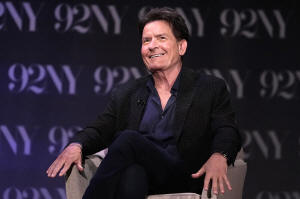Charlie Sheen was once a leading man in Hollywood. His new book reveals
how it unraveled
[September 10, 2025]
By ITZEL LUNA
A young Charlie Sheen once had Hollywood in his pocket, starring in
culture-shaping films like “Wall Street” and “Platoon” before eventually
becoming the highest-paid actor in television.
But underneath the glory laid decades of drug abuse, seven worried
family interventions, innumerable drug-fueled escapades and countless
affairs. The actor’s tumultuous journey toward sobriety is unabashedly
laid out in Sheen’s tell-all memoir, “The Book of Sheen.”
The 359-page book was released by Gallery Books Tuesday. It reveals the
story behind Sheen's rise, fall and eventual sobriety in 2017.
Here are some details about “Book of Sheen.”
What does Charlie Sheen’s book cover?
“The Book of Sheen” begins when Sheen’s life does, recounting his
near-death experience during birth and meticulously narrates his wild
journey through Hollywood, time he spent running from rehabilitation
centers, partying with celebrities and three divorces.
Sheen was raised in a family full of actors. His father, Martin Sheen,
found success in the ’70s, starring in the crime drama “Badlands” and
“Apocalypse Now.”
He spent his childhood creating fiction films on a Super 8 film camera
with his older brothers, Emilio and Ramon, he describes in the book.
“We were trying our best to mimic Dad’s profession: making the fake
stuff seem real, while doing so fearlessly,” Sheen wrote.

How did Sheen become famous?
Sheen, 60, born as Carlos Irwin Estévez to Martin Sheen and Janet
Templeton, was exposed to the acting world early, having grown up on his
father’s film sets.
The budding actor eventually took on the stage name of Charlie Sheen,
following his father, who made a similar change. He landed his first
major acting role in the 1986 Vietnam War drama, “Platoon” and starred
in the crime drama “Wall Street” alongside his father and Michael
Douglas the following year.
The actor eventually found success in television, with a starring role
in the popular CBS sitcom “Two and a Half Men.” It made him the
highest-paid male actor on television, reportedly earning $1.8 million
per episode during the show’s eighth season.
Sheen is widely known for his tumultuous professional and personal life.
He spent the ’80s and ’90s addicted to alcohol and hard drugs, with
explosive divorces, an HIV diagnosis and assault allegations dominating
the tabloids.
“Two and a Half Men” was forced into a hiatus in 2011 when Sheen
underwent his third rehab attempt. That season was eventually canceled
and Sheen’s contract was terminated after he made offensive public
statements toward creator Chuck Lorre.
Sheen maintained a relatively low public profile after his decision to
become sober in late 2017.
Sheen's early years of fame
As the child and brother of movie stars, Sheen has had famous friends
and acquaintances for much of his life, from Sean Penn and Rob Lowe to
George Clooney and Laura Dern.
By his mid-20s, he had partied with Madonna and Jack Nicholson — on the
same night — played basketball with Michael Jordan, met Bill Clinton
when he was governor of Arkansas and talked baseball with Reggie Jackson
while both were guests at Hugh Hefner’s Playboy Mansion.

“Platoon” made him a star and changed his life, no wish or desire left
unmet.
He learned to live hard early on, drinking and snorting cocaine in high
school and conceiving his first child at 18. Around the time he filmed
“The Rookie,” which came out in 1990, loved ones staged the first of
what he writes have been seven interventions. Among those urging him to
clean up: Lowe, brother Emilio and father Martin, one of his junior high
school teachers, a yoga master and the star and director of “The
Rookie,” Clint Eastwood, who by telephone told him: “You got this, just
a minor speed bump, go make me proud.”
Sheen ushered in the '90s by assembling what he called The Jackson 5, a
group of men that included Nicolas Cage. He describes in detail the
drug-filled adventures they went on as they “tested the ceiling of
stardom against the reach of the law.”
The Jackson 5 landed him in rehab for the first time and he left a new
man, that is, until a chance encounter with a Foster’s Lager at Cage's
house exactly a year later, which is when he first broke his sobriety.
Sheen's drug abuse
Sheen was first introduced to crack cocaine in 1992 by a girlfriend, an
experience that he wrote “rewired my frontal cortex.” He knew then the
drug could ruin his life, and vowed to never touch it again — a promise
he kept until he began regularly using in 1996. He tried what he
referred to as “dope” about a year after, given to him by a registered
nurse he met at a party.
His drug use “comes down to choices … I didn’t wake up with a needle
sticking out of my arm, I made the decision to put it there,” he wrote.
The drug use impacted his acting roles. Sheen was almost fired from the
1997 action comedy “Money Talks” after “a thirty-two-hour cocaine
nosebleed” halted filming. His addiction to pills became too much to
manage while on the set of “Two and Half Men,” as he describes being in
“full withdrawal” by the middle of tapings.

[to top of second column]
|

Charlie Sheen discusses his book "The Book of Sheen" at the 92nd
Street Y on Monday, Sept. 8, 2025, in New York. (Photo by Charles
Sykes/Invision/AP)
 Sheen cycled in and out of his
sobriety for decades, including numerous rehab stays that he managed
to escape almost every time.
In 1999, he celebrated his first year of sobriety while filming
“Rated X.” But, he writes that he picked up crack cocaine, along
with alcohol and prescription pills, once again while in a
relationship with Brooke Mueller, who he married in 2008. Their
subsequent split in 2011, coupled with the infamous “20/20"
interview he did that same year, which led to his firing from “Two
and a Half Men,” pushed him further into his substance abuse.
After announcing his HIV diagnosis to the world on the “Today” show
in 2015, Sheen quit hard drugs, he wrote, but the alcohol was harder
to shake. The drinking, he thought at the time, was “a friend for
life to help me navigate the potholes and landmines the future had
in store.”
Ultimately, it was a car ride to an appointment for his daughter,
Sam, who was 13 at the time, that sealed his long-term sobriety in
December 2017. He had been drinking that morning and unable to
drive. “There was only one thing that felt worse than betraying
myself, and that was failing my children,” Sheen wrote.
Sheen and Heidi Fleiss
Half way through the book, Sheen describes first meeting Heidi
Fleiss, most famously known as “The Hollywood Madam,” at a club in
1992. He described the intoxicating rush of hiring call girls,
knowing there’s an “outside chance of opening the door to handcuffs
instead of girls.”
Fleiss was later arrested in 1993, and Sheen, who'd written various
checks to her in return for sexual encounters with women, “cut a
deal for immunity.” In return, he provided a recorded testimony
against Fleiss, who ultimately served 20 months at federal prison in
California.
He describes in the book a sense of embarrassment for testifying
against Fleiss, which was motivated by a fear of a pandering charge,
which could've resulted in five years in jail. If he could go back,
he wrote, “no chance I'd play ball like I did.”

Sheen's marriages and divorces
“The Book of Sheen” describes in detail what led to Sheen's three
marriages and divorces.
Just before the Fleiss fallout, Sheen embarked on a whirlwind
romance with Donna Peele, his first wife, which quickly turned sour
soon after their marriage in 1995. He made a drunken spectacle at
the wedding, got drunk during the flight home from the honeymoon —
during which the pilot let him fly the plane for about 90 seconds —
and threw their wedding rings out of a sunroof during an explosive
fight. “I blame myself for most of our dustups, with booze being the
easiest culprit to pin it on,” he wrote. “Our situation needed a
villain to blame.”
Sheen met his second wife, Denise Richards, on a film set in the
early 2000s and reconnected shortly after, when she guest starred on
“Spin City.” The pair dated for about two months before he proposed,
which he said was spurred by the Sept. 11, 2001, attacks and his
three-and-a-half year sobriety.
“For the first time in years,” he wrote, “my feelings were
accessible and based in reality.” Right around the time Sheen was
cast on “Two and a Half Men,” Richards had given birth to their
daughter, Sam, and their home life was crumbling. Sheen turned to
prescription pills and the two divorced shortly after their second
daughter was born.
Sheen gave up pills for a while after his second divorce. He met
Mueller shortly after, and the two got married a year later. He
attributed the quickness to “feeling so overwhelmed, beat down, and
outnumbered in my life.” The couple had twin boys in 2009 and he
began using pills again shortly after that. Mueller, who was also
sober when they met, began taking them as well, which eventually led
to them both using hard drugs.
“The split from B left me numb, both in spirit and from the amount
of booze and dope I showered my brain with to quell the debilitating
frustrations,” Sheen wrote. Today, he described his relationship
with Richards as “solid,” and with Mueller as “sustainable.”

What does Sheen say about the book?
The first line of his book had occurred to Sheen years before he
actually sat down to write the memoir, he said during a conversation
Monday with actor and writer David Duchovny during an event at 92nd
Street Y, New York.
“On September 3rd, 1965 in New York City at 10:58 p.m. I was born
dead,” the actor recited from memory on stage. That near-death
experience right at birth, caused by an umbilical strangulation, set
the tone for much of the rest of his life, Sheen said.
“People always say you got more lives than a cat, right, and they
come in at nine or something,” Sheen said. “So I already got — We’re
already at eight, right?”
The book was released eight years after he got sober, time that he
said gave them the distance necessary to reflect on his life
experiences.
“I needed this much distance between that other life, those other
versions of me,” Sheen said. “I don't think that I could've
committed to this and delivered the type of focus and passion and
discipline that it required unless I also had the distance.”
___
AP National Writer Hillel Italie contributed to this report.
All contents © copyright 2025 Associated Press. All rights reserved |